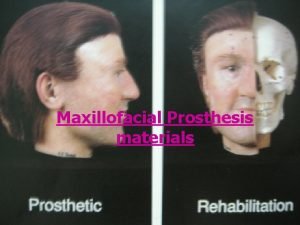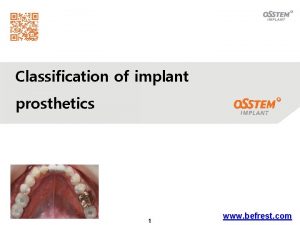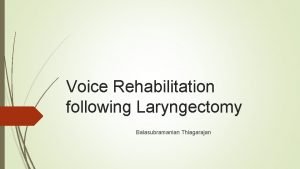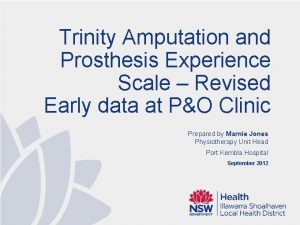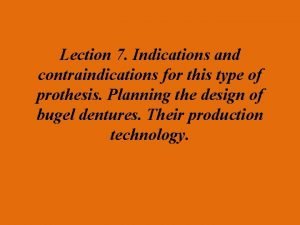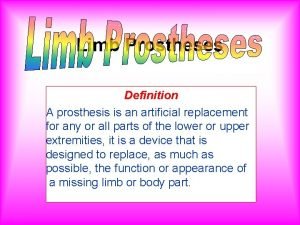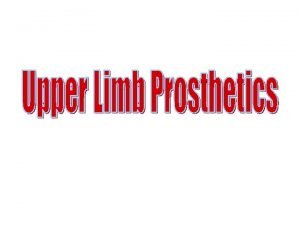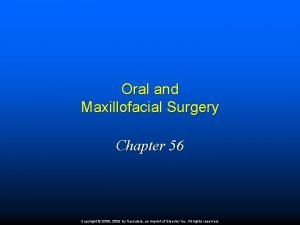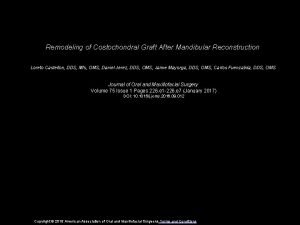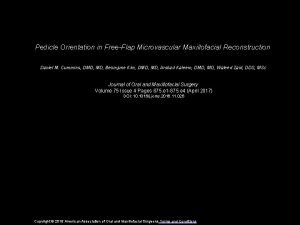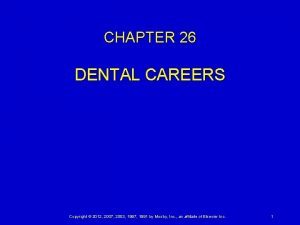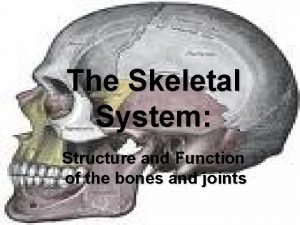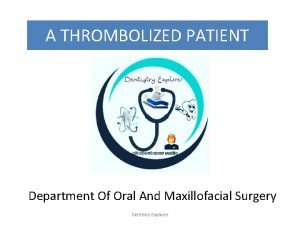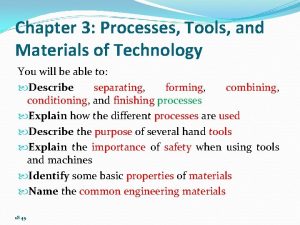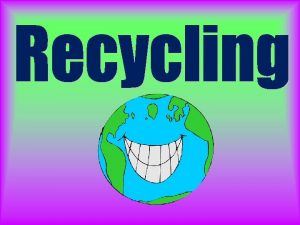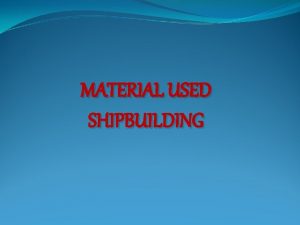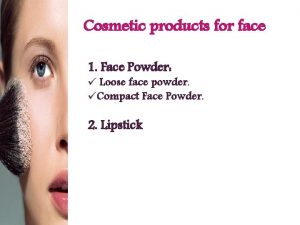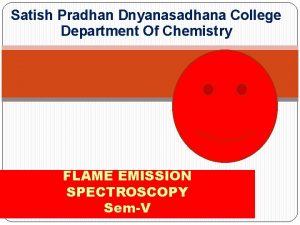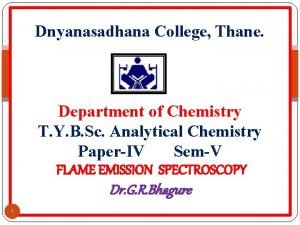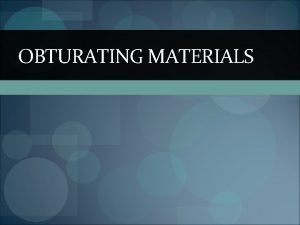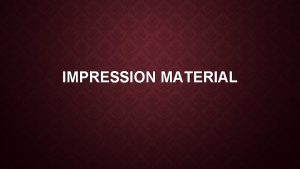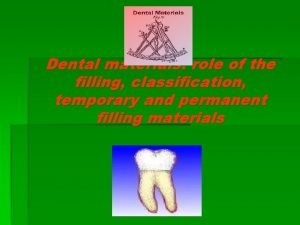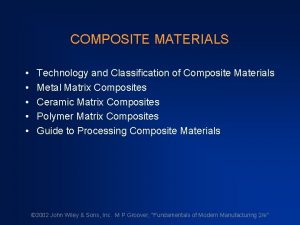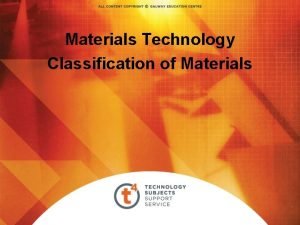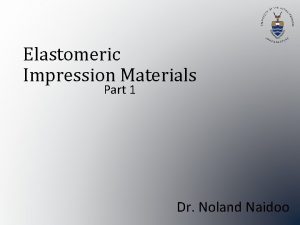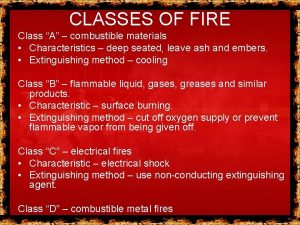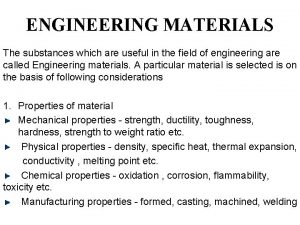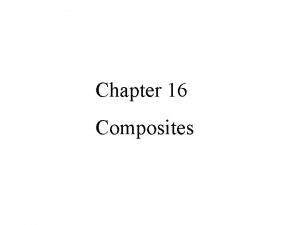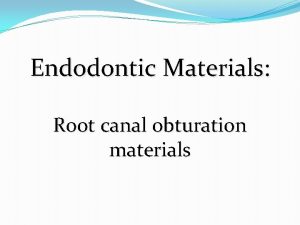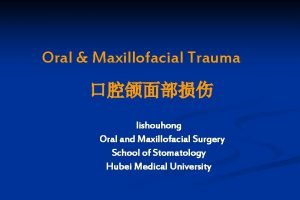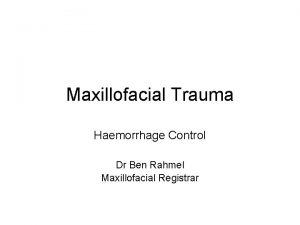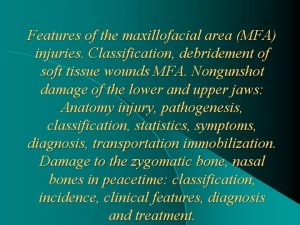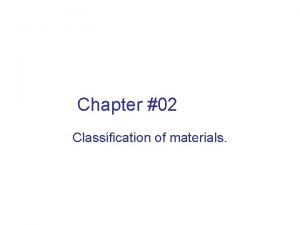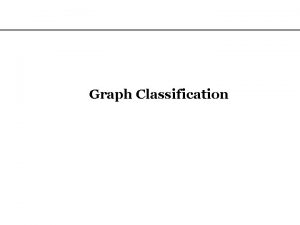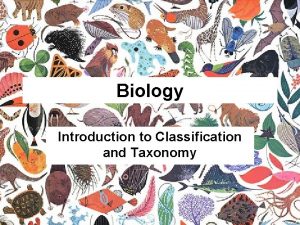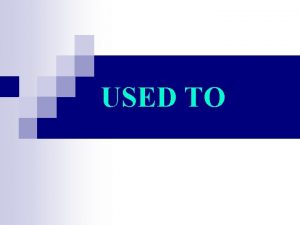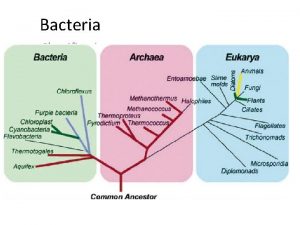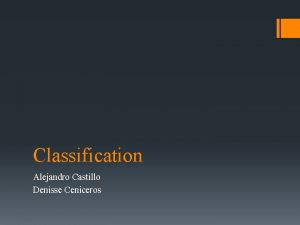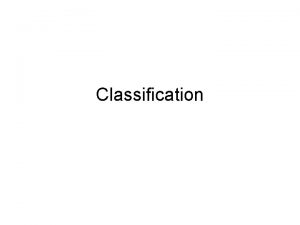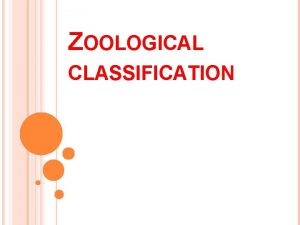Maxillofacial Prosthesis materials Introduction Classification of materials used















































- Slides: 47

Maxillofacial Prosthesis materials

Introduction

Classification of materials used in Maxillofacial Prosthodontics Impression materials Composition Plaster of Paris Plaster bandage Materials for fabrication Prosthetic materials Pattern materials Mould making Silicone putty Flasks Alginate Separating medium Pigmentation materials Auxiliary materials Materials for Retention Intrinsic Extrinsic sealant Extrinsic Aerosil 130 Adhesives Silastic foam Magnets Macrocellular foam Implants Stellon crown Others Comfeel Primers

Classification of Maxillofacial Prosthesis materials • According to Beumer: 1. Acrylic resins. 2. Acrylic copolymers. 3. Polyvinyl chloride & copolymers. 4. Chlorinated polyethylene. 5. Polyurethane elastomers. 6. Silicone elastomers – HTV, RTV, Foaming silicones. 7. New materials- Silicone block copolymers, Polyphosphazenes.

Classification of Maxillofacial Prosthesis materials • According to ANUSAVICE: 1. Latex- a tripolymer of Butyl acrylate, Methyl methacrylate & Methyl methacrylamide. 2. Vinyl Plastisols. 3. Silicone Rubbers. 4. Polyurethane Polymers.

Ideal properties Ø 1. Ideal Physical & Mechanical properties: a. Dynamic properties comparable to tissues. b. High edge strength, high elongation, high resistance to abrasion, high tear strength & high tensile strength. c. Low coefficient of friction, low glass transition temperature, low specific gravity, low surface tension & low thermal conductivity. d. Odorless, Non-inflammable, No water sorption. e. Translucent. f. Softness compatible to tissue & variable flexibility without addition of leachable plasticizer.

Ideal properties Ø 2. Ideal Processing characteristics: a. Adjustability. b. Chemically inert after processing. c. Dimensionally stable during & after processing. d. Ease of intrinsic & extrinsic coloring. e. Ease of mold fabrication & processing. f. Ease of repair & refabrication if needed. g. Fidelity of detail reproduction. h. High viscosity for maintaining even dispersion of colorants. i. Long shelf life & working time.

Ideal properties Ø 2. Ideal Processing characteristics: (contd) j. Low viscosity for ease of processing. k. Low processing temperature. l. Low sensitivity to contamination during processing. m. Non-inflammable, non-toxic & non-porous. n. No polymerization by-products. o. Reusable molds. p. Retain intrinsic & extrinsic coloration during use. q. Short processing time.

Ideal properties Ø 3. Ideal Biological properties: a. Compatible with supporting tissues. b. Non allergic & non toxic. c. Cleansable with disinfectants without losing details at surface or margins. d. Color stability & dimensional stability. e. Flexibility comparable to tissue & stable at high temperatures. f. Inert to solvents & skin adhesives. g. Resistance to environmental discoloration & growth of microorganisms. h. Inexpensive.

Individual material 1. ACRYLIC RESINS: - used in areas with little movement. (Orbital or Ocular etc) Advantages: readily available, easy in coloring, good strength, compatible with adhesives, long service, color stability, easily repaired or relined. Disadvantages: rigidity, discomfort, high thermal conductivity, no duplication possible.

Individual material 2. ACRYLIC COPOLYMERS: Advantages: soft & elastic. Disadvantages: poor edge strength, degrade in sunlight, processing & coloration is difficult, gets stained easily. - Antonucci & Stansbury reported new generation development in this.

Individual material 3. POLYVINYL CHLORIDE (PLASTISOLS) & COPOLYMERS: ( Realistic, Mediplast, Prototype III) - a rigid , clear, tasteless & odorless - glass transition temperature higher - plasticizers are added - cross linking agents Recently a copolymer – 5%to 20% Vinyl acetate in it. It is more stable, more flexible but less chemically resistant.

Individual material 3. POLYVINYL CHLORIDE (PLASTISOLS) & COPOLYMERS: ( contd) Advantages: flexible, adaptable to coloration to yield good appearance. Disadvantages: leaching of plasticizers, tear easily, easily stained, degrade easily, soil easily, metal molds required, short service life, poor dimensional stability.

Individual material 4. CHLORINATED POLYETHYLENE: - Lewis & Castleberry - similar to Polyvinylchloride in both chemical composition & physical properties. - Gettleman also reported (CPE 726/19 -15) - clinical trials just initiated

Individual material 5. POLYURETHANE ELASTOMERS: initiator - Diisocyanate + Polyol - processing (1000 C) Advantages: elastic (without compromising edge strength), flexible, easy coloration, superior cosmetic results. Disadvantages: difficult to process, moisture sensitive, no color stability, service life less, poor compatibility with adhesives, toxic.

Individual material 6. SILICONES: - Production - dimethyl dichlorosiloxane + water Classified into four groups: i) Implant grade ii) Medical grade iii) Clean grade iv) Industrial grade

Individual material a. HEAT VULCANIZED SILICONES (HTV) : - Polydimethyl vinyl siloxane copolymer with approx. 0. 5% vinyl side chains, 2, 4 -dichlorobenzoyl peroxide as an initiator & a silica filler obtained from burning methyl silanes. - processing temperature ( 2200 C). - difficult to pigment.

Individual material i. SILASTIC 370, 372, 373, 4 -4514, 4 -4515: - white opaque material, highly viscous. - dichlorobenzoyl peroxide or platinum salt as catalyst - fillers added to harden (silica) -Advantages: excellent thermal stability, color stability, biologically inert. -Disadvantages: less elastic, low edge strength, opaque & lifeless, difficult to color extrinsically, require metal molds.

Individual material ii. PDM SILICONES: - Lontz and Schweiger& Lontz - Abdelnnabi evaluated properties

Individual material iii. Q 7 -4635, Q 7 -4650, Q 7 -4735, SE-4524 U: - a new generation evaluated by Bell - single component system - unlimited shelf life

Individual material b. ROOM TEMPERATURE VULCANIZED SILICONES (RTV) : - used more often then any other - good physical & mechanical properties - vinyl & hydride containing siloxanes - chloroplatinic acid as ctalyst - tetraethoxysilane as cross-linking agent

Individual material i. SILASTIC 382, 399 : - stannous octoate catalyst & orthoalkyl silicate as cross linking agent - Advantages: color stable, clear solutions, easy to process, require stone molds - Disadvantages: poor strength, difficult to color, cosmetic results inferior

Individual material ii. MDX 4 -4210 : - chloroplatinic acid catalyst & hydro-methyl siloxane as cross-linking agent. (800 C for 1 hour) -Moore reported improved properties Advantages: no reaction by-product, increased elongation, surface texture & shore hardness, non-toxic, color stable, simple processing, compatible with adhesives

Individual material iii. SILASTIC 891 (Silastic Medical Adhesive Silicone Type A) : - Udagama & Drane - translucent, non flowing, polymerizes in air - Advantages: no need of molds, no catalyst, compatible with wide range of colorants. - in 1987 Udagama used it along with polyurethane film to improve its edge strength. - Farah suggested a combination of: 40% MDX 4 -4210 + 60% MED. A 891

Individual material iv. COSMESIL / SILSKIN 2 SYSTEMS : - Woofaardt described it - two curing system: a) Platinum cure: - utilizes vinyl terminated Silicone & a platinum catalyst - addition reaction so no by-products. Hence no shrinkage - poisoned by latex - working time 1 hr & curing at 1000 C for 1 hr

Individual material iv. COSMESIL / SILSKIN 2 SYSTEMS (contd) : (b) Tin cure: - utilizes hydroxy terminated silicone fluids & a Tin catalyst - condensation reaction so by-product is formed - is very robust & cures against most substrates/ conditions - working time 1 hr & cures in 24 hr at room temperature.

Individual material v. A-2186 (FACTOR II) : - a recently developed material initially showed improved properties. - but Haug reported that it doesn't retain them when subjected to environmental variables. - two types of curing system similar to Cosmesil

Individual material 7. NEW MATERIALS: (i) Silicone block copolymers: - incorporates Polymethyl methacrylate into Siloxane blocks. - more tear resistant (ii) Polyphosphazenes: - developed as a resilient denture liner

Physical properties • Tensile strength • Maximum Elongation • Pants Tear energy • Dynamic Modulus

Physical properties (CRAIG) Material Plasticized polyvinylchloride Tensile Max. % Pants tear Dynamic strength elongation test modulus (psi) (dynes/cm (MPa) × 106 3. 99 215 4. 32 Polyurethane 0. 83 422 6. 7 3. 46 HTV 5. 87 441 Doesn't tear but stretches as in tensile 4. 66 RTV 4. 20 445 Elongation. 2. 12

Physical properties (BEUMER) Elastomer A-2186 Silastic 382 MDX 4 -4210 MDX 4 -4515 MDX 4 -4516 Manufacturer Factor II Dow corning Color Translucent Gray Shore hardness 25 43 >25 52 72 Tensile strength (psi) 900 350 >550 1350 1175 %Elongation 650 160 >350 450 370 Tear strength (psi) 90 NA 50 NA NA Specific gravity 1. 12 1. 13 1. 12 1. 15 1. 21 Dow corning Translucent

Physical properties (CHALIAN) Silastic S- Silastic 382 Silastic 399 6508 Durometer 26 45 50 Tensile (psi) 785 300 525 %Elongation 490 100 230 Tear (psi) 65 20 29

Mold making materials Ø Silicones. Ø Surgical plaster of Paris- for investing of all prosthesis & blanking out undesired areas of impression models. Ø Kaffir “D” dental stone- for all impression models. Ø Beta Dur 700 hard stone- vacuum mixed & used as a topping investment as it is hard & protects fine recorded details. Its color allows easy placement of localized color. Ø Plaster / pumice- 30/70 ratio used for blanking areas that need to be free of silicone in the mold (Keith Thomas)

Flasks Ø Two part rectangular Aluminium alloy flasks, self clamping. Ø Available in sizes : Small 6” × 4 ¼” × 3 ¼ ” Medium 6 ¾ ” × 6 3/8 ” × 6 1/12 ” Large 9” × 6” × 7 ½ ” Shallow 8” × 5” × 2 ¾ ” (Keith Thomas)

Separating media Ø Soap- useful for two part plaster moulds, also if used in a 5% solution may be used as a releasing agent for silicone prosthesis. Ø Cold mould seal- all plaster moulds, also as a releasing agent for silicone. Ø Medi-Mould wax mould sealant & releasing agent - sealing porous mould surfaces. Release agent for silicone.

Pattern materials Ø Waxes: hard, soft , skin colored etc. - Baseplate wax , Korecta wax , Utility Wax Ø Clay

Materials for retention Double sided adhesive tape Primers & Adhesives

Materials for retention Implants

Materials for retention Adhesive magnet plate Neo- mini magnets

Materials for retention Other materials Sprung steel head band Spectacles

Materials for Pigmentation Ø Extrinsic & intrinsic pigments. Ø Basic shades are mainly metal oxides like: Nickel oxide - Brown Manganese oxide - Lavender Titanium oxide - Yellowish brown Iron oxide - Brown Copper oxide - Green

Auxiliary materials Ø Extrinsic sealant Ø Aerosil 130 - to reduce shine & alter viscosity Ø Silastic foam dressing Ø Macrocellular foam Ø Stellon crown & bridge- to facilitate construction of custom made finger nails. Ø Adhesive removers or solvents

Auxiliary materials Ø Comfeel ( skin conditioner) - it is Ethoxyethyl acid copolymer ethyl acetate - creates an elastic protective barrier - applied to clean skin & after 1 -2 min it forms a film.

Fabrication of the Prosthesis Impression Master cast Wax / clay pattern Try-in Investment Two part or three or four part mould Color matching/ intrinsic pigmentation Compression molding Processing Finishing Surface / extrinsic pigmentation

Limitations & Degradation Ø Discoloration due to – - external environmental factors. - due to loss of external coloration. Ø Degradation of properties – - tear at margins - change in surface texture - elongation at margins - deterioration of static & mechanical properties

Conclusion Ø Ultimate challenge to a material is its clinical performance. Ø Laboratory testing should be correlated to clinical performance. Ø Sweeney in 1972 & Lewis & Castleberry in 1980 gave specifications for maxillofacial elastomer. Ø Future research: - improving the properties to service life. - color stable & better color matching.

 Classification of maxillofacial prosthesis
Classification of maxillofacial prosthesis Befrest
Befrest Tokyo artificial larynx
Tokyo artificial larynx Trinity amputation and prosthesis experience scales
Trinity amputation and prosthesis experience scales Chopart amputation
Chopart amputation Contraindications of removable partial denture
Contraindications of removable partial denture Artificial limb
Artificial limb Function of prosthesis
Function of prosthesis Radiant impressions custom breast prosthesis
Radiant impressions custom breast prosthesis Classification of woodwork hand tools
Classification of woodwork hand tools Chapter 56 oral and maxillofacial surgery multiple choice
Chapter 56 oral and maxillofacial surgery multiple choice Emergency management of maxillofacial trauma
Emergency management of maxillofacial trauma Odontogenic inflammatory diseases of maxillofacial area
Odontogenic inflammatory diseases of maxillofacial area Maxillofacial
Maxillofacial American academy of oral and maxillofacial radiology
American academy of oral and maxillofacial radiology Maxillofacial
Maxillofacial Chapter 26 oral and maxillofacial surgery
Chapter 26 oral and maxillofacial surgery Zygomatic arch
Zygomatic arch Chapter 56 oral and maxillofacial surgery
Chapter 56 oral and maxillofacial surgery Cant stop the feeling go noodle
Cant stop the feeling go noodle Matter useful and harmful
Matter useful and harmful Man made materials
Man made materials Adapting and adopting materials
Adapting and adopting materials Direct materials budget with multiple materials
Direct materials budget with multiple materials Simple electrical gadgets
Simple electrical gadgets Appearance of the tainos
Appearance of the tainos Magnetic materials used in electrical machines
Magnetic materials used in electrical machines Process materials by hand with hand tools
Process materials by hand with hand tools Recycling involves taking used materials
Recycling involves taking used materials Materials used in shipbuilding
Materials used in shipbuilding Evaluation test for face powder and compact
Evaluation test for face powder and compact Quotations or paraphrases used to support a point
Quotations or paraphrases used to support a point In a premix burner used in fes the fuel used is
In a premix burner used in fes the fuel used is In a premix burner used in fes the fuel used is
In a premix burner used in fes the fuel used is Classification of obturation techniques
Classification of obturation techniques Negative reproduction dental
Negative reproduction dental Permanent medicated filling
Permanent medicated filling Classification of composite materials
Classification of composite materials Classification of smart materials
Classification of smart materials Non elastic impression materials
Non elastic impression materials Which is main characteristic of a class c fire?
Which is main characteristic of a class c fire? Applications of insulating materials
Applications of insulating materials Two way stretch marketing
Two way stretch marketing What is the engineering materials
What is the engineering materials Mercaptan impression material
Mercaptan impression material Classification of composites
Classification of composites Cutting in workshop
Cutting in workshop Classification of obturating materials
Classification of obturating materials
